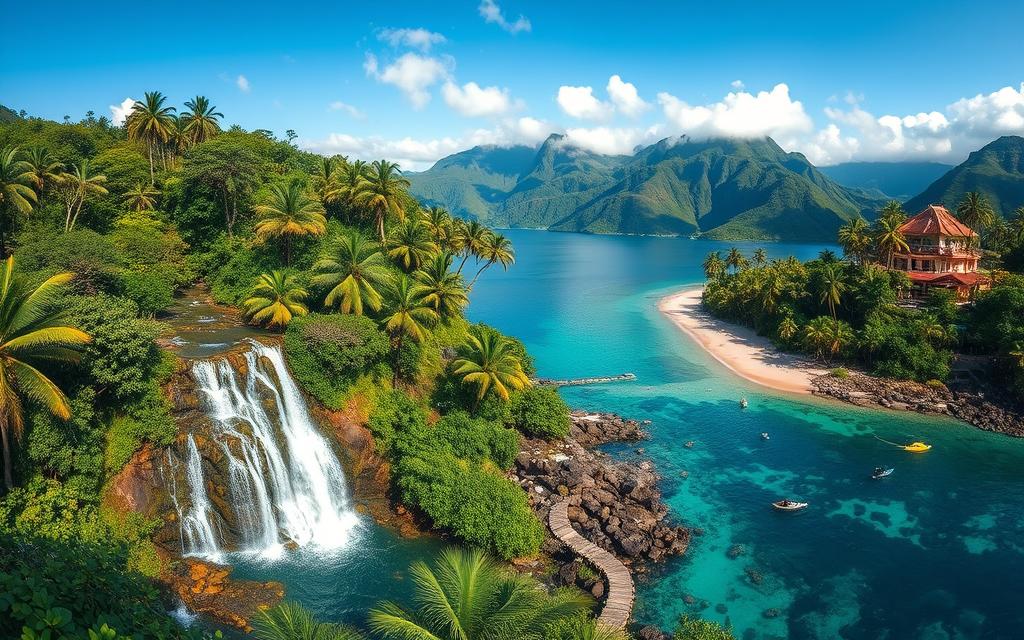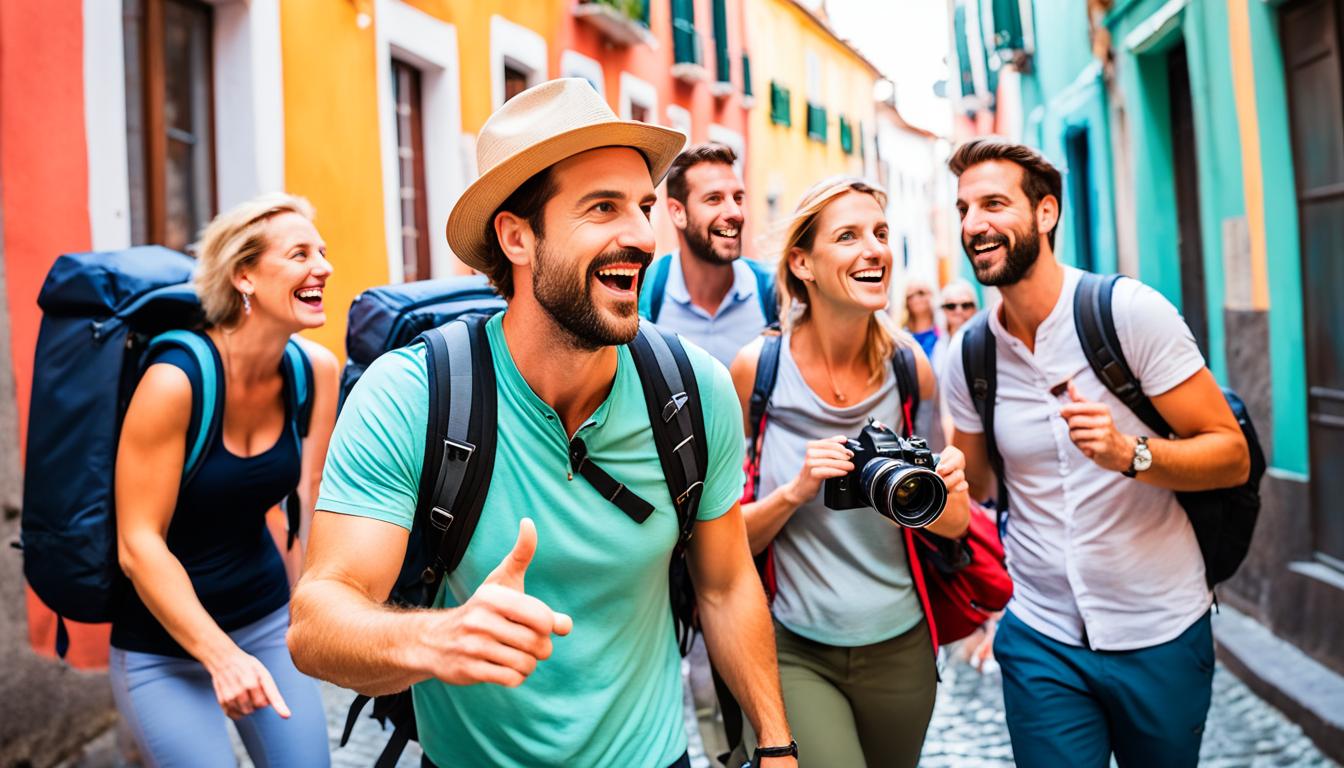As the sun dipped below the horizon, casting a warm glow over the lush forest canopy, Sarah couldn’t help but feel a sense of awe and wonder. She had always dreamed of exploring the world’s most captivating natural wonders, and today, her adventure was about to begin.
Ecotourism, a rapidly growing trend, offers travelers the chance to immerse themselves in the beauty of our planet while actively contributing to its preservation. From the rugged terrain of the Himalayas to the pristine beaches of the Galapagos Islands, these ecotourism destinations provide a unique opportunity to connect with nature and support local communities.
As Sarah embarked on her journey, she couldn’t wait to discover the wonders that awaited her. Whether it was trekking through the lush Costa Rican rainforests, snorkeling the vibrant Great Barrier Reef, or exploring the untamed Amazon Rainforest, each destination promised to captivate her senses and leave a lasting impression.
What is Ecotourism?
Ecotourism is a way to travel that helps protect nature and supports local people. It aims to educate visitors about the environment. The International Ecotourism Society says it’s about traveling responsibly to natural places.
Defining Ecotourism and Its Principles
The idea of ecotourism started in the 1970s. The term “ecotour” was first used in 1973, and “ecotourism” in 1982. It’s about traveling to nature in a way that’s good for the environment and local people.
Ecotourism is not just any nature trip. It’s about understanding and appreciating nature’s beauty and fragility.
Why Ecotourism is Important
Ecotourism helps us learn about and protect our planet’s beauty. It’s a way to travel that doesn’t harm the environment. It supports conservation and teaches people about living sustainably.
More than five million people go on ecotourism trips each year. Most are from the United States, but many also come from Western Europe, Canada, and Australia.
Ecotourism has many benefits, but it also has risks. The tourism industry is growing fast, with ecotourism expected to be worth $299 billion by 2026. Travelers today want to travel in a way that’s good for the planet.
| Country | Ecotourism Certification Program |
|---|---|
| Costa Rica | National Certification for Sustainable Tourism (CST) |
| Australia | Ecotourism Australia Certification |
| Kenya | Eco-Tourism Kenya Certification |
| Estonia | Estonian Ecotourism Quality Label |
| Sweden | Nature’s Best Ecotourism Certification |
Ecotourism was recognized in the 1970s and defined in 1982. It focuses on sustainability and reversing harmful relationships between tourists and locals. But, some companies may not always follow through on their green promises.
Certifications for ecotourism places vary. But, groups like the Global Sustainable Tourism Council look for conservation, community, culture, and commerce in their standards.
Ecotourism Destinations
The world is full of amazing places for ecotourism. Each spot offers a chance to see nature and help protect it. From Costa Rica’s rainforests to Palau’s islands, these places are great for sustainable travel.
Costa Rica is known for its green efforts. It has many parks and reserves. Visitors can see lots of plants and animals here.
The Galapagos Islands in Ecuador are also special. They are home to unique animals and plants. Eco-tourists can see tortoises and iguanas in their natural homes.
In the Amazon Rainforest, you can learn from local people. They show you how to care for the forest. This helps protect this important place.
Places like Iceland, Bhutan, Kenya, and Slovenia also focus on ecotourism. They offer ways to see nature while helping the environment. You can hike or see wildlife without harming the planet.
| Destination | Peak Season | Unique Ecotourism Offerings |
|---|---|---|
| Rwanda | June to September, December to February | Volcanoes National Park, gorilla trekking |
| Costa Rica | Mid-December to April | National parks, wildlife viewing, cloud forests |
| Sabah, Malaysia | January to October | Rainforests, Mount Kinabalu, marine life |
| New Zealand | February | Hiking, wildlife encounters, geothermal activities |
| Jamaica | April | Eco-lodges, nature trails, cultural experiences |
These places offer many ways to enjoy nature and help the environment. By choosing these vacations, you can see the world and help protect it.

Costa Rica: Embracing the Pura Vida
Costa Rica is a leader in ecotourism, welcoming over 3 million tourists each year. They come to see the stunning nature and the country’s green efforts. Costa Rica lives by the “Pura Vida” (pure life) motto, with 25% of its land protected for parks and reserves.
Corcovado National Park: A Biodiversity Hotspot
Corcovado National Park on the Osa Peninsula is a top spot for nature lovers. It’s one of the most diverse places on Earth, with many species of trees, insects, and animals. The government limits visitors to protect this unique ecosystem, and guides are required.
Volunteering Opportunities in Costa Rica
Costa Rica offers many chances to volunteer in ecotourism. You can help on ecological farms, wildlife projects, and community programs. Volunteering lets you dive into the local culture, learn about environmental protection, and help preserve nature.
| Ecotourism Highlights in Costa Rica | Key Statistics |
|---|---|
| Renewable Energy Generation | Over 90% of Costa Rica’s energy is generated from renewable sources. |
| Carbon Neutrality Goal | Costa Rica aims to be the first carbon-neutral country by 2050. |
| Protected Land Area | Approximately 25% of Costa Rica’s land is dedicated to national parks, reserves, and protected areas. |
| Ecotourism Contribution to GDP | Ecotourism activities account for around 25% of Costa Rica’s GDP. |
Costa Rica’s focus on ecotourism has boosted its tourism and made it a happy country. By living the Pura Vida and protecting nature, Costa Rica shows the world how to travel responsibly.
The Galapagos Islands: Evolution’s Living Museum
The Galapagos Islands, a UNESCO World Heritage Site off Ecuador, are a top spot for Galapagos Islands ecotourism. This archipelago, with 19 islands and 127 islets, is a natural wonder. It shows the amazing diversity of life shaped by evolution. The islands are a sustainable tourism hotspot, protecting their ecosystem while offering visitors a chance to see its wonders responsibly.
Responsible Tourism in the Galapagos
To protect the Galapagos Islands, a conservation fee of $100 is needed for all visitors. The number of tourists is limited. Boat routes are planned to avoid overcrowding, ensuring a sustainable tourism experience that doesn’t harm the islands’ sensitive environments.
Eco-Lodges and Cruises in the Galapagos
Travelers to the Galapagos Islands have many eco-friendly accommodation options. The Galapagos Safari Camp offers deluxe tented accommodations and guided tours. The Santa Cruz II is a luxury vessel for exploring the islands with daily guided excursions and activities like snorkeling and kayaking, all promoting responsible tourism.

The Galapagos Islands show the power of sustainable tourism and conservation. They offer visitors a unique chance to see nature’s wonders responsibly. By protecting this UNESCO World Heritage Site, the Galapagos Islands inspire and captivate travelers from all over.
Exploring the Amazon Rainforest
The Amazon rainforest is a wonder in nine South American countries. It’s home to millions of species. For years, indigenous communities have led ecotourism here. They teach visitors about their ways and protect the rainforest from harm.
Indigenous-Led Ecotourism Initiatives
Ecotourism in the Amazon helps local communities earn money. It also lets visitors learn about the area’s culture. Sustainable hotels and eco lodges in the Amazon Rainforest employ staff from local communities and use solar energy for electricity.
Visitors can help with activities like tracking jaguars and planting trees. They can also go on jungle cruises. These trips help protect the rainforest and offer a chance to see unique wildlife.
Cristalino Lodge is a great place to stay in the Amazon. It runs on solar power and has different rooms for groups. Birdwatchers can see 586 species nearby. Guests can use kayaks, canoes, and yoga mats.
“Ecotourism in the Amazon is a powerful tool in the battle to protect the rainforest from deforestation, illegal logging, and climate change, as it can offer a viable source of income for local communities and facilitate cultural exchange and understanding.”
Bhutan: A Carbon-Negative Ecotourism Model
Bhutan, a small Himalayan kingdom, is a top example of sustainable ecotourism. It’s the world’s first carbon-negative country. Environmental conservation is at the heart of Bhutan’s identity. The country has set a new standard for responsible travel.
The Sustainable Development Fee (SDF) is key to Bhutan’s ecotourism. Visitors pay $65 a day. This money funds environmental projects, education, healthcare, and more. Bhutan leads in carbon-negative tourism by offsetting tourism’s carbon footprint.
Bhutan goes beyond tourism in its commitment to sustainability. It aims to keep 60% of its land as forests. This has made Bhutan one of the greenest nations. The country also focuses on Gross National Happiness (GNH), which values environmental conservation and cultural preservation.
Bhutan’s impact on global ecotourism is significant. It shows the way for carbon-negative tourism and sustainability. As the world faces climate change, Bhutan’s example offers hope and a blueprint for a sustainable future.
| Key Facts About Bhutan’s Ecotourism | Value |
|---|---|
| Sustainable Development Fee (SDF) | $65 per person per day |
| Forestry Coverage | 70% of the country’s land |
| Carbon Emission Status | Carbon-negative |
| Renewable Energy Sources | Hydroelectric power, wind power, biogas, solar power |
| Gross National Happiness (GNH) Pillars | Environmental conservation, culture preservation, sustainable development, good governance |
Bhutan’s dedication to sustainable development and environmental conservation is inspiring. It has shown the world a holistic approach to tourism. This approach has made Bhutan a remarkable example for others to follow.
Kenya: Protecting the Big Five
Kenya is a top example of ecotourism in Africa. The government created ‘Ecotourism Kenya’ to promote tourism that protects nature and helps local people. Over 1 million tourists visit Kenya’s 54 national parks each year. They come to see the famous ‘Big Five’ – lions, elephants, buffaloes, leopards, and rhinos.
The Kenyan government is dedicated to stopping illegal poaching and banning single-use plastics. They also push for sustainable tourism. New tech like drones and satellite tracking has cut down poaching. This helps keep the Big Five alive for future generations.
But Kenya still faces big challenges. These include growing populations, climate change, and losing habitats. Despite these, Kenya leads in wildlife protection. It uses community-based conservancies and ecotourism to protect its nature and support local people.
Source Links
- https://www.worldpackers.com/articles/eco-tourism-examples
- https://www.traveloka.com/en-en/explore/destination/pl-top-ecotourism-destinations-in-the-world/212841
- https://en.wikipedia.org/wiki/Ecotourism
- https://www.vox.com/even-better/23792484/sustainable-travel-ecotourism-respect-tips
- https://www.everysteph.com/top-ecotourism-destinations-in-the-world/
- https://yesim.app/blog/11-top-ecotourism-destinations/
- https://costaricarealestate.net/embracing-the-pura-vida-lifestyle-unveiling-the-essence-of-costa-rica/
- https://www.adventureparkcostarica.com/living-the-pura-vida-a-guide-to-embracing-the-costa-rican-lifestyle/
- https://whc.unesco.org/en/list/1/
- https://www.rjourneys.com/destinations_category/the-galapagos-islands/
- https://www.originaltravel.co.uk/travel-blog/ecotourism-in-the-amazon-rainforest
- https://www.traveldifferently.org/authentic-travel/ecotourism-in-brazil-5-days-in-the-amazon-rainforest
- https://www.nationalgeographic.com/travel/article/carbon-negative-country-sustainability
- https://borgenproject.org/sustainable-tourism-in-bhutan/
- https://africasafaritravellers.com/wildlife-conservation-and-ecotourism-efforts-in-kenya/
- https://www.volunteerforever.com/article_post/the-big-5-conserve-and-protect-africas-iconic-animals/
- https://www.linkedin.com/pulse/spotting-big-five-best-wildlife-reserves-kenya-jemba-najib-y9xkf

